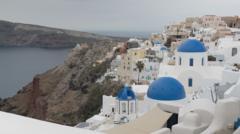Perched high above the Aegean Sea, Santorini is renowned for its stunning vistas and bustling tourism economy, yet below its picturesque surface lurks the threat of catastrophic volcanic activity. A recent research mission aboard the British royal research vessel, Discovery, is exploring the geological risks underneath the island, which is famously shaped by a massive eruption dating back to 1600 BCE.
The past month has seen nearly half of Santorini's population of 11,000 evacuate, echoing the gravity of the island's seismic risks after a series of earthquakes reminded residents of their situation's fragility. Grounded by the dual forces of tectonic movements, scientists are now investigating the underwater characteristics of Santorini's volcanoes, which have remained largely unmonitored compared to their terrestrial counterparts.
Leading the research is Prof. Isobel Yeo of the National Oceanography Centre, who emphasizes the critical need to understand the underwater hazards that could unleash dangerous eruptions without warning. Her team hopes to identify seismic patterns that could indicate future volcanic activity. While Santorini's last significant eruption occurred in 1950, a "period of unrest" in 2012 raised further alarm bells when magma activity was detected beneath the surface.
“A mix of seawater and magma can radically change the explosive potential of underwater volcanoes,” Yeo explains. “Recent events like the 2022 Hunga Tonga eruption have demonstrated just how devastating these underwater eruptions can be.” Beneath the ship, geysers of hot gases erupt from vents in the seafloor that could become crucial clues as scientists work to form a clearer picture of the underwater landscape.
The discovery team is mapping out the region's hydrothermal systems while sailing towards Kolumbo, another volcano a few miles away. Although immediate eruptions are not anticipated, the pressing need for knowledge about these volcanic systems is paramount, especially in informing the Civil Protection Agency of Greece for hazard management.
Prof. Paraskevi Nomikou, a geologist from Santorini and part of the governmental emergency team, stresses the importance of this research in providing local residents with vital data on volcanic activity and areas that may need to be avoided during an eruption. With a history steeped in stories of seismic events narrated by her grandfather, she feels a personal duty to safeguard her community.
As the expedition unfolds, scientists share anxieties about the impact of eruptions on tourism, which is a lifeline for Santorini’s economy. Local businesses, like the wedding photography services of Eva Rendl, feel the strain of diminished bookings since the earthquake swarm began in February, reflecting broader concerns about how natural threats could discourage visitors from flocking to this idyllic island.
While some tourists remain undeterred by the seismic activity—like newlyweds Tom and Kristina who dreamt of tying the knot near a volcano—others express the need for reassurance through reliable scientific information. The research team aims to provide that by developing geological data that could help predict and mitigate the risks posed by the underwater volcanoes.
In a precarious balance between natural beauty and geological peril, Santorini stands as a reminder of nature's unpredictable power, compelling both scientists and tourists to tread carefully on its alluring shores.




















